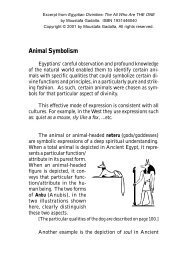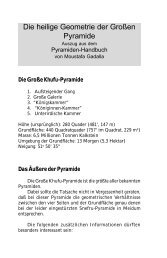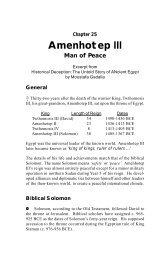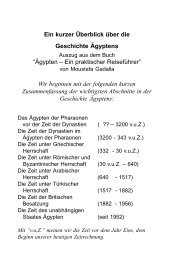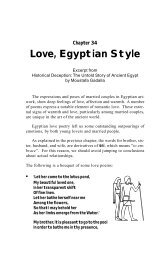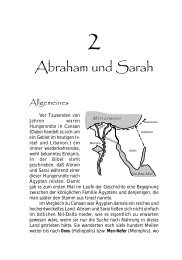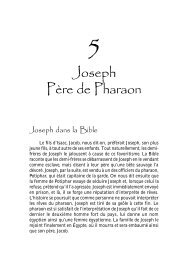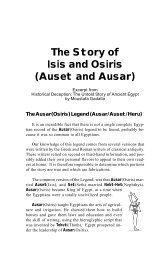The Exodus
The Exodus
The Exodus
Create successful ePaper yourself
Turn your PDF publications into a flip-book with our unique Google optimized e-Paper software.
Chapter 29<strong>The</strong> <strong>Exodus</strong>Excerpt fromHistorical Deception: <strong>The</strong> Untold Story of ANcient Egyptby Moustafa GadallaGeneralAfter the death of Twtankhamen, his uncle Aye reigned for fouryears before he disappeared from the scene. Horemheb ascended tothe throne at that time.Horemheb was an army general and obtained his right to the throneby marrying Queen Nefertiti’s sister, Mutnedjemet.Kings of the Later 18 thand Early 19 th DynastiesKing Length of reign DatesTwthmosis III (DAVID) 54 1490-1436 BCEAmenhotep II 23 1436-1413 BCETwthmosis IV 8 1413-1405 BCEAmenhotep III (SOLOMON) 38 1405-1367 BCEAkhenaton (MOSES) (alone) 6 1367-1361 BCESemenkhkare - 1361-1361 BCETwtankhamen (JESUS) 9 1361-1352 BCEAye (EPHRAIM) 4 1352-1348 BCEHoremheb 13 1348-1335 BCEAmarnaKings19 th DynastyRamses I 2 1335-1333 BCESeti I 29 1333-1304 BCERamses II 67 1304-1237 BCE
<strong>The</strong> <strong>Exodus</strong>: <strong>The</strong> Bitter Divorce3God also reassured Moses that his life would not be in any dangerif he returned to Egypt because “all those who wished to kill youare dead”.<strong>The</strong> particulars of the events indicate that Moses/Akhenatonhad different objectives. Moses/Akhenaton, who had been inhiding in the wilderness for about a quarter of a century, foundan opportunity to restore himself to the throne, as the legalheir. He decided to try to reclaim his throne from Ramses I(same as Pa-Ramses).Preparation for the Face-OffAfter spending about 25 years hiding in the wilderness and fearfulfor his life, the biblical Moses began the preparation for a comeback.Strangely enough, his fear for his life was totally gone, andhe was not worried about confronting Ramses I.His only problems, according to the Bible, were how to succeed, inobtaining the support of the Israelites!Logically, it was the Egyptian Akhenaton (not the biblicalMoses) who needed the support of the Israelites. After beingrejected by the majority of Egyptians, Akhenaton decided tochoose the Israelites as his own people. When the time came tochallenge the new Pharaoh, his main concern was not a confrontationwith Ramses I, but to acquire the backing of theIsraelites.He had two problems:His first problem was that he did not speak the Israelites’ languagesufficiently well. Moses/Akhenaton complained about the difficultyin communicating with the Israelites:“And Moses said unto the Lord, 0 my Lord, I am not eloquent... I am slow of speech and of a slow tongue.” <strong>Exodus</strong>,4:10Aaron, the Israelite feeding brother of his early childhood, was
4 Historical Deception: <strong>The</strong> Untold Story of Ancient Egyptcalled upon to be his spokesman:“And the anger of the Lord was kindled against Moses,and he said, Is not Aaron the Levite thy brother? I knowthat he can speak well ...” <strong>Exodus</strong>, 4:14His second problem was to reach a compromise between his religiousbeliefs and those of the Israelites. <strong>The</strong> following passagesfrom the Old Testament, do not make any sense because one doesn’texpect a Jewish leader to have such a religious problem with hisown people.Let us follow the strange passage from the Old Testament:1. “And Moses said unto God, Behold when I come unto thechildren of Israel, and shall say unto them, <strong>The</strong> God ofyour fathers hath sent me unto you; and they shall say tome, What is his name? what shall I say unto them?”“And God said unto Moses, I AM THAT I AM: and hesaid, Thus shalt thou say unto the children of Israel, IAM (i.e. Jehovah) hath sent me unto you.” <strong>Exodus</strong>, 3:13-142. Three chapters later, in the same Book of <strong>Exodus</strong>, we face astranger passage:“And I appeared unto Abraham, and unto Isaac, and untoJacob, by the name of God Almighty, but by my name JE-HO-VAH was I not known to them.” <strong>Exodus</strong>, 6:3<strong>The</strong> contents of the last passage, in which God informs Moses thathe never appeared to the patriarchs by the name Jehovah, is reallystrange, because the name Jehovah was used in several chapters, ofthe preceding Book of Genesis, in the Bible.It seems that Akhenaton would not reject the name ofhis God, the Aten, for the purpose of gaining the supportof the Israelites. <strong>The</strong>refore an outlandish compromisewas reached in Sinai, by which the Israelitescontinued to write their old personal name of God, Je-
<strong>The</strong> <strong>Exodus</strong>: <strong>The</strong> Bitter Divorce5hovah. However Jehovah could never be read aloudagain and should, in every case, be pronounced‘Adonai’. As mentioned earlier, ‘Adonai’ is the samename of the God of Akhenaton.<strong>The</strong> Site of the Face-OffIt appears that both at the time of the birth of Moses and whenhe came back to confront Pa-Ramses, the ruling Pharaoh was inresidence in the vicinity of Goshen, where the Israelites had beenallowed to settle.Zarw was the major city in Goshen. Zarw occupied the old siteof the previous Hyksos’ capital city of Avaris. At the end of the18th Dynasty, the town of Pa-Ramses was built at the same site ofAvaris and Zarw.<strong>The</strong> archeological investigation in this area, found three differentwalls at three levels, confirming what we know from literarysources of Pi-Ramses/Avaris/Zarw that all three occupied one andthe same location. This area is the present-day Kantarah, and itsneighborhood.<strong>The</strong> Face-OffMoses’ mission was not just a case of getting the Israelites out ofEgypt. <strong>The</strong>re was some type of contest, as acknowledged in thebiblical description of the events.<strong>The</strong> following is the more logical sequence of events:Moses went to Zarw (Goshen region) to present his case that afterthe death of Horemheb, he was the ‘legitimate heir’ (which meansMos in ancient Egypt) and that Pa-Ramses had no just right to thethrone. Since Moses was in hiding for 25 years, in Sinai, he had toprove his qualifications to the throne. <strong>The</strong> Egyptian priests andelders were there to judge and not to perform magic. Moses made
6 Historical Deception: <strong>The</strong> Untold Story of Ancient Egypthis case as follows:A. He showed that he was a King by presenting his staff topped bya brass serpent, the symbol of Pharaonic authority that alsoidentified him as the son of Amenhotep III.<strong>The</strong>re was no magic rod, as is also evident in the followingdocuments.1. <strong>The</strong> Hebrew word used in the Bible toindicate the rod of Moses is ‘nahash’,which has the meanings of both ‘serpent’and ‘brass’. <strong>The</strong> Haggadah, the legendarypart of the Talmud, confirms the royalcharacter of Moses’s rod: “<strong>The</strong> rodwhich Moses used ... was shaped andengraved in the image of a scepter.”2. More affirmation of the point is made inthe second Book of Kings, 18:3-4:“And he did that which was right in the sight of theLord, according to all that David his father did.”“He removed the high places and brake the images,and cut down the groves; and brake in pieces thebrazen serpent that Moses had made; for unto thosedays the children of Israel did burn incense to it.”It is clearly stated that Moses’ magic rod was in reality abronze serpent.B. He also performed the Heb-Sed festival rituals, which were notknown to ordinary citizens.During the Heb-Sed festivals, which were attended by EgyptianKings, including Akhenaten, to rejuvenate their power, itwas the custom to take part in rituals that included both the‘serpent rod’ and ‘hand’ rituals performed by Moses.
<strong>The</strong> <strong>Exodus</strong>: <strong>The</strong> Bitter Divorce7Here, Moses does not sound like a magician, but more like someonewho presents evidence of his royal background and legitimacy.Pa-Ramses was not educated and trained to become a king, likeMoses/Akhenaton was, and therefore could not match the presentationmade by Moses.<strong>The</strong> wise men bowed the knee in front of him, confirming his superiorrights to the throne. But Pa-Ramses used his army to crush therebels. Moses was allowed to leave again for Sinai accompaniedby the Israelites. In Sinai the followers of Akhenaten were joinedsubsequently by some Bedouin tribes (the Shasu), who are to beidentified as the Midianites of the Bible.<strong>Exodus</strong>Moses and his followers may have made their way to Sinai viathe marshy area, to the south of Zarw and north of Lake Temsah andpresent-day Ismailia. This is the possible location for the biblicalaccount of the “miraculous” crossing of the Red Sea by Moses andhis people, and the subsequent drowning of the Pharaoh and hisarmy, for the Egyptian chariots would get stuck in the mud. <strong>The</strong>Israelites, traveling on foot, would be able to cross safely.Egyptian records show no evidence of this event, but the shortreign of Ramses I (c. 1335-1333 BCE) came to an end upon hisdeath and can be logically related to these events.<strong>The</strong> combination of the name, the life, the nature of reign andthe sudden death of Ramses I, is one of the important pieces of thepuzzle in the identification of the Pharaohs in the Bible.<strong>The</strong> combination between matching available records, the processof elimination of other possible characters, and the records of suchcharacters, identify Ramses I as the biblical “Pharaoh Who KnewNot Joseph”.Although Sinai was a part of Egypt, it did not have a residentgovernor. During the 18 th and 19 th Dynasties the area was placedunder the control of two officials, the Royal Messenger in All For-
8 Historical Deception: <strong>The</strong> Untold Story of Ancient Egypteign Lands and the Royal Chancellor.After entering Sinai, the Israelites traveled for three days withoutfinding water. When they found some water later on, it was sobitter that they could not drink it. <strong>The</strong>y protested to Moses, asking:“What are we to drink?” This protest, and at times threatsto choose a new leader who would take them back to Egypt, is arecurrent event in the rest of the Pentateuch. <strong>The</strong>y really did notwant to leave Egypt, in the first place, and wanted to go back.. Itwas Moses who forced them to follow him.Ramses I’s son and successor, Seti I (C. 1333-1304 BCE), receiveda message about the chaos in Sinai: ‘<strong>The</strong> Shasu enemies areplotting rebellion. <strong>The</strong>ir tribal leaders are gathered in one place, standingon the foothills of Khor (a general term for Palestine and Syria),and they are engaged in turmoil and uproar. Each of them is killing hisfellow. <strong>The</strong>y do not consider the laws of the palace.’Seti I did not wait for the burial of his father (Ramses I) or even hiscoronation, when he led his army promptly to Sinai.<strong>The</strong> Shasu and the Israelites<strong>The</strong> descendants of Jacob (numbering seventy just 75 years beforeSeti I’s reign) were of no significant number and/or stature towarrant a special name for them, in Egyptian records. When Moses/Akhenaton fled to Sinai and stayed there, for about 25 years, hehad to establish alliances with the different and small Bedouintribes in Sinai. <strong>The</strong> composition of this alliance is recorded in theEgyptian history, as the ‘Shasu enemies’.Seti I’s war scenes, on the exterior north wall of the great HypostyleHall at Karnak, show that his first campaign against the Shasuoccurred when they attempted to reach Canaan via the Road ofHeru(Horus), the ancient highway connecting Egypt with westernAsia. This took place immediately after the <strong>Exodus</strong> from Egypt,possibly when they trespassed to obtain water from military settlementsalong that road. Seti I chased them as far as the city ofCanaan, Gaza, and, as a result, killed their leader, Moses, and many
<strong>The</strong> <strong>Exodus</strong>: <strong>The</strong> Bitter Divorce9of his followers. Subsequently, they fled into Sinai for what theOld Testament calls ‘the forty years of wandering’.To further prove that the Shasu and the Israelites are the samegroup of people, scholars studied:1. <strong>The</strong> Shasu appearance in Sinai, in Year 1 of Seti I’s reign, andtheir subsequent movements over the next 100 years. Thisinformation was provided from ancient Egyptian records.2. <strong>The</strong> biblical accounts of the <strong>Exodus</strong> and their subsequent movementsover 100 years.Scholars concluded that both of them followed the same route atexactly the same time sequence, i.e. the Shasu and the Israelites areone and the same group of people.It was about 100 years after the Seti I wars against the Shasu,and the settling of the Israelites in Canaan, over the span of manyyears, that the Egyptian records recognized the name Israel, on theso-called Israel Stela. (Read more about it under the chapter, IsraelStela.)<strong>The</strong> Death of Moses<strong>The</strong> account in the Old Testament of the failure of Moses toreach the Promised Land, his death and his burial in an unmarkedgrave is another curious episode.We are told initially that, when his followers complained of thirst,Moses used his rod to smite a rock and bring forth water. It wascalled ‘the water of Meribah’ — a location in the north-center ofSinai, south of Canaan. It was this action that would later haunthim.Some time later, when the Israelites were camped on the banks ofthe Jordan, near Jericho and opposite Canaan, Moses learned, accordingto the Book of Deuteronomy, that he was to be denied theopportunity to cross the river, no matter how hard he pleaded:
10 Historical Deception: <strong>The</strong> Untold Story of Ancient Egypt“I pray thee, let me go over, and see the good land that isbeyond Jordan, that goodly mountain, and Lebanon.”“...the Lord said ...speak no more unto me of this matter ...”“... thou shalt not go over this Jordan.”Deuteronomy. 3:25-7Later in the Book of Deuteronomy, we have an account of theactual death of Moses. <strong>The</strong> Lord said to him:“Get thee up into this mountain Abarim, unto MountNebo, which is in the land of Moab’ (the bordersbetween Sinai and eastern Jordan) ‘that is overagainst Jericho; and behold the land of Canaan,which I give unto the children of Israel for apossession: And die in the mount ... Because yetrespassed against me among the children of Israelat the waters of Meribah-Kadesh, in the wildernessof Zin ... thou shalt not go thither unto the landwhich I give the children of Israel.” 32:49-52It is irrational to believe that God would punishMoses for providing water for his thirsty people.It is more logical to believe that trespassing ontoEgyptian water wells, may cause the authoritiesto punish him for such a violation.<strong>The</strong> Talmud provides a different account than the Old Testamentof how Moses died. <strong>The</strong>re is a Talmudic reference to a confrontationand a struggle between Moses and the ‘Angel of Death’on the Mount before he died. This had persuaded some biblicalscholars to believe that Moses was killed.It seems more likely that Moses, using his royal scepter (symbolof authority), entered one or more of the Egyptian fortressesalong Horus Road to obtain water from their wells.Such actions were reported to Seti I, who reacted by chasingthe Shasu, here identified as the Israelites, into northern Sinai.If these Talmudic references to the death of Moses are correct,it must have been there that Moses died, at the hand ofSeti I, out of sight of his followers.




